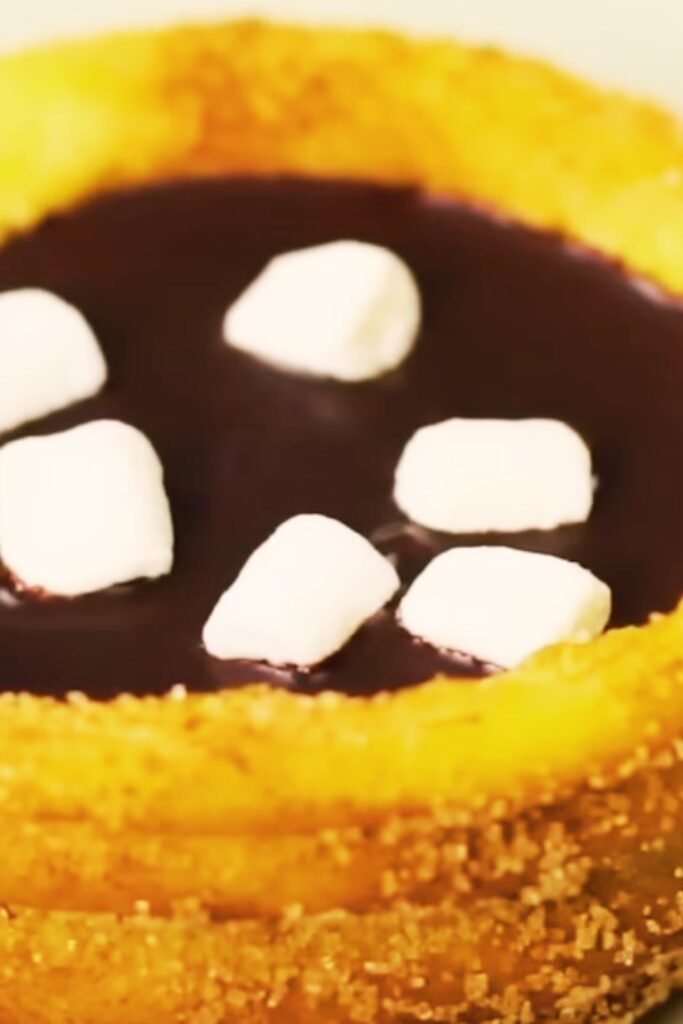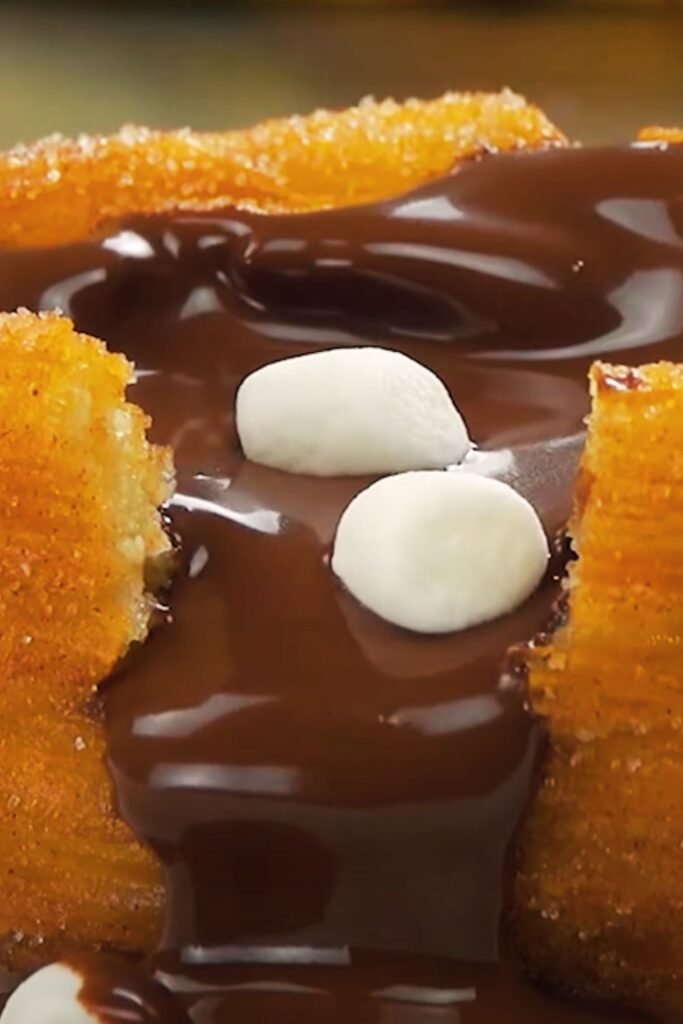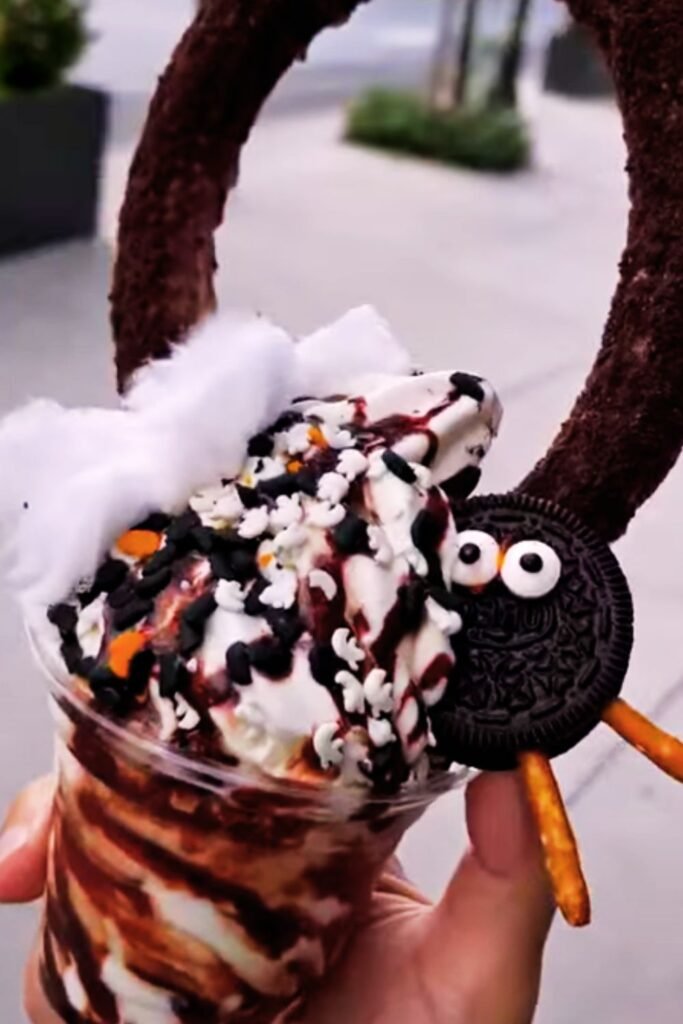There’s something magical about the moment when crispy, cinnamon-sugar coated churros meet creamy, cold ice cream. I’ve been experimenting with dessert combinations for years, and let me tell you – churro ice cream bowls are hands down one of my most beloved creations. These edible bowls aren’t just desserts; they’re edible art pieces that bring joy to every single bite.
When I first stumbled upon the idea of turning churros into bowls, I was skeptical. Could something so delicate really hold ice cream? After countless kitchen experiments and a few delicious failures, I’ve perfected the technique that creates sturdy, flavorful bowls that complement rather than compete with your favorite frozen treats.
What Makes Churro Ice Cream Bowls Special
Churro ice cream bowls represent the perfect marriage of textures and temperatures. The warm, crispy exterior provides a delightful contrast to the cold, smooth ice cream nestled inside. Unlike traditional bowls that simply contain your dessert, these edible vessels enhance every spoonful with their distinctive cinnamon-sugar coating and tender interior.
The beauty of these bowls lies in their versatility. I’ve served them at dinner parties where guests couldn’t stop photographing their desserts, and I’ve made them for quiet Sunday afternoons when I wanted something special just for myself. They work equally well for formal occasions and casual family gatherings.
Key Benefits of Churro Ice Cream Bowls
Texture Contrast: The crispy churro shell creates an incredible textural experience when paired with smooth ice cream. Each bite delivers both crunch and creaminess.
Temperature Play: The contrast between the room-temperature churro bowl and cold ice cream creates a sensory experience that keeps your taste buds engaged.
Visual Appeal: These bowls are Instagram-worthy without trying. Their golden-brown color and unique shape make every serving look professionally crafted.
Customization Options: From the churro flavoring to ice cream choices and toppings, these bowls offer endless possibilities for personalization.
Interactive Dessert: Guests love the novelty of eating their bowl, making this dessert a conversation starter and memorable experience.
Essential Ingredients and Equipment
Churro Bowl Ingredients
| Ingredient | Quantity | Purpose | Substitution Options |
|---|---|---|---|
| Water | 1 cup | Creates steam for choux pastry | None – essential |
| Unsalted Butter | 1/2 cup (8 tbsp) | Provides richness and structure | Margarine (not recommended) |
| Salt | 1/4 teaspoon | Enhances flavor | Sea salt or kosher salt |
| All-purpose Flour | 1 cup | Main structure component | Bread flour (adjust liquid) |
| Large Eggs | 4 whole eggs | Binding and leavening | Duck eggs (adjust quantity) |
| Vanilla Extract | 1 teaspoon | Flavor enhancement | Almond extract (1/2 tsp) |
| Vegetable Oil | 6-8 cups | For deep frying | Canola oil, peanut oil |
Cinnamon Sugar Coating
| Ingredient | Quantity | Notes |
|---|---|---|
| Granulated Sugar | 1 cup | Fine sugar works best |
| Ground Cinnamon | 2 tablespoons | Ceylon cinnamon preferred |
| Nutmeg | 1/4 teaspoon | Optional but recommended |
Essential Equipment
Deep Fryer or Heavy Pot: You’ll need something that can maintain consistent oil temperature. I prefer using a heavy-bottomed Dutch oven with a candy thermometer.
Bowl-Shaping Molds: Small oven-safe bowls work perfectly. I use 4-inch diameter ceramic ramekins turned upside down.
Piping Bag with Star Tip: A large star tip (1/2 inch opening) creates the classic churro ridges that help hold the cinnamon sugar.
Wire Cooling Racks: Essential for proper cooling and sugar coating adhesion.

Step-by-Step Churro Bowl Creation Process
Preparing the Choux Pastry Base
Creating the perfect churro dough requires attention to detail and proper technique. I’ve learned that the key to success lies in achieving the right consistency and temperature at each stage.
Start by combining water, butter, and salt in a medium saucepan over medium heat. Bring this mixture to a rolling boil, ensuring the butter completely melts and incorporates. The moment you see vigorous bubbling, remove the pan from heat and immediately add all the flour at once.
Stir vigorously with a wooden spoon until the mixture forms a smooth ball that pulls away from the sides of the pan. This usually takes about 2-3 minutes of continuous stirring. The mixture should look slightly glossy and feel smooth when properly combined.
Return the pan to low heat for about 60 seconds, stirring constantly. This step helps cook out excess moisture and creates a better texture in your final churros. You’ll know it’s ready when you see a thin film forming on the bottom of the pan.
Transfer the mixture to a mixing bowl and let it cool for 5 minutes. This cooling period prevents the eggs from scrambling when added. Add eggs one at a time, beating thoroughly after each addition. The mixture will look broken at first, but keep beating – it will come together into a smooth, pipeable consistency.
Shaping the Bowls
Here’s where the magic happens. Heat your oil to 375°F (190°C) in a deep fryer or heavy pot. The oil temperature is crucial – too hot and your churros will brown before cooking through; too cool and they’ll absorb excess oil.
Transfer your dough to a piping bag fitted with a large star tip. Working quickly but carefully, pipe the dough in a spiral pattern around your inverted bowl molds, starting from the bottom and working upward. Create overlapping layers to ensure structural integrity.
The key to successful bowl formation is maintaining consistent pressure while piping and ensuring each layer connects properly with the previous one. I typically create 3-4 layers, depending on the desired height.
Frying Technique
Carefully lower the dough-covered molds into the hot oil. The initial sizzling is normal – this indicates proper oil temperature. Fry for 2-3 minutes until the bottom begins to set and turn golden brown.
Using tongs, carefully flip the entire mold and continue frying for another 2-3 minutes. The churro bowl should develop a deep golden-brown color and feel firm to the touch. Total frying time typically ranges from 4-6 minutes depending on size and oil temperature.
Remove from oil and drain on paper towels for 30 seconds before carefully removing the mold. The bowl should hold its shape and feel sturdy enough to support ice cream.

Coating and Finishing Techniques
The Perfect Cinnamon Sugar Blend
While your churro bowls are still warm (but not hot enough to melt ice cream), roll them in the cinnamon sugar mixture. The warmth helps the coating adhere better and creates that classic churro flavor profile I love so much.
I prefer to mix my cinnamon sugar in a shallow dish, allowing me to roll each bowl thoroughly. Pay special attention to the interior surfaces – these will come in direct contact with your ice cream and deserve equal coating attention.
Cooling and Storage
Allow coated bowls to cool completely on wire racks before filling. This typically takes 15-20 minutes at room temperature. Properly cooled bowls will maintain their crispness and won’t begin melting your ice cream immediately upon contact.
Ice Cream Selection and Pairing Guide
Classic Flavor Combinations
| Ice Cream Flavor | Compatibility Rating | Flavor Notes |
|---|---|---|
| Vanilla Bean | ★★★★★ | Perfect neutral base, highlights churro flavors |
| Cinnamon | ★★★★★ | Amplifies the churro experience |
| Dulce de Leche | ★★★★★ | Creates authentic Latin flavor profile |
| Chocolate | ★★★★☆ | Rich contrast to sweet cinnamon |
| Strawberry | ★★★★☆ | Fresh fruit balances sweetness |
| Coffee/Espresso | ★★★★☆ | Sophisticated adult flavor combination |
| Caramel Swirl | ★★★★☆ | Doubles down on caramel notes |
Premium Flavor Pairings
For special occasions, I love experimenting with artisanal ice cream flavors that complement the churro’s warm spice profile. Mexican chocolate ice cream with hints of chili creates an authentic experience that pays homage to churros’ cultural origins.
Salted caramel ice cream provides a sophisticated balance to the sweet cinnamon coating, while brown butter ice cream echoes the nutty notes developed during the churro frying process.
Topping Ideas and Garnish Options
Traditional Toppings
Whipped Cream: Light and airy, it doesn’t compete with the churro’s texture while adding visual appeal.
Caramel Sauce: Drizzle warm caramel over the ice cream for an indulgent touch that complements the cinnamon flavors.
Chocolate Sauce: Classic hot fudge creates a temperature contrast that’s absolutely divine.
Creative Garnish Ideas
Crushed Churros: Save some churro pieces to sprinkle on top for extra texture and visual interest.
Toasted Nuts: Almonds or pecans add crunch and complement the cinnamon beautifully.
Fresh Berries: Strawberries or raspberries provide color and acidity to balance the sweetness.
Powdered Sugar Dusting: A light dusting adds elegance and extra sweetness.

Troubleshooting Common Issues
Bowl Structural Problems
Cracking During Frying: Usually indicates oil temperature is too high or dough was too thick in certain areas. Maintain consistent oil temperature and ensure even dough distribution.
Soggy Bottoms: Often caused by insufficient oil temperature or overcrowding the fryer. Ensure oil returns to proper temperature between batches.
Uneven Browning: Typically results from inconsistent dough thickness or oil temperature fluctuations. Monitor temperature closely and pipe evenly.
Dough Consistency Issues
Too Thick to Pipe: Add beaten egg one tablespoon at a time until desired consistency is reached. The dough should be smooth but hold its shape when piped.
Too Thin: This usually happens when eggs are added too quickly or while the dough is too warm. Unfortunately, this batch may need to be discarded and restarted.
Make-Ahead Strategies and Storage
Advance Preparation
Churro bowls can be made up to 2 days in advance when stored properly. Allow them to cool completely, then store in airtight containers at room temperature. They’ll maintain their crispness and be ready for filling when needed.
For longer storage, freeze unfilled bowls for up to one month. Wrap individually in plastic wrap, then place in freezer bags. Thaw at room temperature for 30 minutes before serving.
Day-of Assembly Tips
I recommend filling churro bowls just before serving to maintain optimal texture contrast. Pre-scoop ice cream and store in the freezer, then quickly assemble when ready to serve.
Nutritional Considerations and Modifications
Dietary Adaptations
Gluten-Free Version: Substitute all-purpose flour with a gluten-free flour blend designed for baking. The texture will be slightly different but still delicious.
Dairy-Free Options: Use plant-based milk ice creams and substitute butter with vegan alternatives in the churro dough.
Reduced Sugar: Cut the cinnamon sugar coating by half or use a sugar substitute blend designed for baking.
Nutritional Information Per Serving
| Component | Calories | Fat (g) | Carbs (g) | Protein (g) |
|---|---|---|---|---|
| Churro Bowl | 285 | 18 | 26 | 6 |
| Vanilla Ice Cream (1/2 cup) | 140 | 7 | 16 | 3 |
| Total Per Serving | 425 | 25 | 42 | 9 |
Serving Suggestions and Presentation
Elegant Plating
Present churro ice cream bowls on chilled plates to help maintain the ice cream’s temperature. I like to place a small doily under each bowl for an elegant touch that also prevents sliding.
Garnish the plate with a light dusting of cocoa powder or cinnamon for professional presentation. A mint sprig adds color contrast and fresh aroma.
Family-Style Serving
For casual gatherings, set up a churro bowl bar where guests can customize their own creations. Provide multiple ice cream flavors, various sauces, and an array of toppings for interactive fun.
Portion Control
Standard churro bowls hold approximately 1/2 to 3/4 cup of ice cream, making them perfectly portioned for dessert. This size provides satisfaction without overwhelming sweetness.
Cultural Context and Origins
Churros originated in Spain and became deeply embedded in Latin American cuisine through colonization. Traditional churros are typically straight or curved sticks, but the bowl adaptation represents the evolution of classic techniques to meet modern presentation desires.
The combination with ice cream reflects the global fusion of dessert traditions, bringing together Spanish pastry techniques with universally beloved frozen treats. This marriage creates something entirely new while respecting both culinary traditions.
Seasonal Variations and Holiday Adaptations
Summer Modifications
During hot weather, I prefer serving churro bowls immediately after coating while they’re still slightly warm. The temperature contrast becomes even more pronounced and refreshing.
Consider lighter ice cream flavors like lemon sorbet or coconut during summer months. These options feel less heavy while maintaining the textural contrast that makes these desserts special.
Holiday Specialties
Christmas: Add crushed peppermint to the cinnamon sugar coating and serve with peppermint bark ice cream.
Halloween: Use orange-colored sugar in the coating and serve with pumpkin spice ice cream.
Valentine’s Day: Shape smaller bowls and serve with strawberry or chocolate ice cream, garnished with fresh berries.
Professional Tips from My Kitchen
After making hundreds of churro bowls, I’ve discovered several techniques that consistently improve results. First, always check your oil temperature with a thermometer rather than guessing. Consistent temperature produces consistent results.
Second, don’t rush the cooling process. Properly cooled bowls maintain their structure better and provide superior texture contrast. I’ve learned patience pays off in dessert making.
Third, practice your piping technique on parchment paper before attempting to pipe around molds. Consistent pressure and speed create more uniform bowls that hold together better during frying.
Q&A Section
Q: How far in advance can I make churro bowls? I recommend making churro bowls no more than 2 days in advance for optimal freshness and crispness. Store them in airtight containers at room temperature to maintain their texture.
Q: What’s the best oil temperature for frying churro bowls? Maintain oil temperature between 370-375°F (188-190°C). This range ensures proper cooking without burning the exterior before the interior sets properly.
Q: Can I bake churro bowls instead of frying them? While possible, baked versions won’t achieve the same crispy texture that makes these bowls special. The frying process creates the characteristic crunch that contrasts beautifully with ice cream.
Q: Why do my churro bowls keep breaking? Breaking usually occurs due to uneven dough distribution or incorrect oil temperature. Ensure consistent thickness when piping and maintain proper frying temperature throughout the cooking process.
Q: What’s the secret to getting cinnamon sugar to stick properly? Coat the bowls while they’re still warm but not hot. The residual heat helps the sugar adhere without melting completely. Room temperature bowls won’t hold coating as effectively.
Q: Can I make mini churro bowls for parties? Absolutely! Use smaller molds and reduce frying time accordingly. Mini versions are perfect for parties and allow guests to try multiple flavor combinations.
Q: How do I prevent ice cream from making the bowl soggy? Ensure bowls are completely cool before filling, and serve immediately after assembly. The contrast between temperatures is part of the appeal, but extended contact will soften the churro.
Q: What ice cream flavors work best with churro bowls? Vanilla, cinnamon, dulce de leche, and caramel flavors complement the churro’s warm spices beautifully. Fruit flavors like strawberry provide nice contrast to the rich, sweet coating.
Q: Can I freeze filled churro bowls? I don’t recommend freezing filled bowls as the texture changes significantly upon thawing. Freeze empty bowls and assemble fresh when ready to serve.
Q: How do I fix dough that’s too thick to pipe? Add beaten egg one tablespoon at a time until the dough reaches proper consistency. It should be smooth and hold its shape when piped but not so thick that it’s difficult to work with.
Churro ice cream bowls represent everything I love about creative dessert making – they combine traditional techniques with innovative presentation to create something truly special. The process might seem involved, but the results are absolutely worth every step. There’s something deeply satisfying about creating edible vessels that enhance rather than simply contain your dessert.
Whether you’re planning an elegant dinner party or just want to treat yourself to something extraordinary, these churro bowls deliver on both flavor and presentation. The combination of textures, temperatures, and flavors creates a memorable dessert experience that guests will be talking about long after the last bite.
I encourage you to experiment with different ice cream flavors and toppings to make this recipe your own. Some of my best discoveries have come from unexpected combinations that initially seemed unusual but turned out to be absolutely delicious. The beauty of cooking lies in these moments of creative discovery, and churro ice cream bowls provide the perfect canvas for your own culinary artistry.